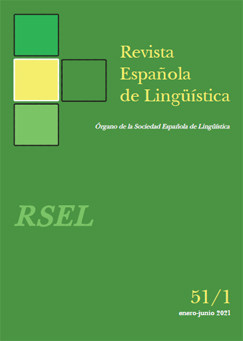Semantic roles associated to the suffix -dor in Spanish and Catalan
http://dx.doi.org/10.31810/rsel.51.1.1
Keywords:
semantic roles; suffix -dor; derivative morphology; Spanish; CatalanAbstract
This article deals with the multifunctionality of the Spanish and Catalan suffix -dor. The aim of the research is to verify if the instrumental and locative meanings of this suffix appeared in Spanish under the influence of Catalan, since the suffix -dorr in Catalan originates in the agentive Latin suffix -tor and as well in the instrumental and locative suffix -tōrium, whereas in Spanish the suffix -tōrium gave as a result the suffix -dero. The results of the quantitative analysis of the semantic roles associated to the suffix -dor in Spanish and Catalan in the period between 1200s and 1500s confirm that Catalan influenced Spanish in this sense.
Downloads
References
Covarrubias, S. de (1611): Tesoro de la lengua castellana o española, Madrid, acceso por Nuevo tesoro lexicográfico de la lengua española, Disponible en http://ntlle.rae.es/ntlle/SrvltGUILoginNtlle (última consulta 15/12/2019).
Davies, M.: Corpus del español: Genre/Historical, Disponible en https://www.corpusdelespanol.org/hist-gen/ (última consulta 15/12/2019).
Dokulil, M. (1962): Tvoření slov v češtině. Teorie odvozování slov, Nakladatelství československé akademie věd, Praga.
Enciclopèdia catalana, SLU: Gran diccionari de la llengua catalana, Disponible en diccionari.cat (última consulta 15/12/2019).
Gutiérrez Rubio, E. (2013): «Agents and instruments in Old Czech nominal word formation», Linguistica Brunensia 61, 1-2, pp. 173-183.
Haspelmath, M. (2003): «The geometry of grammatical meaning: Semantic maps and Cross-Linguistic comparison», en Tomasello, M. (ed.), The new psychology of language, cognitive and functional approaches to language structure 2, Erlbaum, Mahwah, Nueva Jersey y Londres, pp. 211-242.
Institut d’Estudis Catalans: Diccionari català-valencià-balear, disponible en http://dcvb.iecat.net/ (última consulta 15/12/2019).
Institut d’Estudis Catalans: Vocabulari de la llengua catalana medieval de Lluís Faraudo de Saint-Germain, Disponible en http://www.iec.cat/faraudo/ (última consulta 15/12/2019).
Lleal, C. (dir.): Diccionario del castellano del siglo xv en la Corona de Aragón, Disponible en http://ghcl.ub.edu/diccaxv/ (última consulta 15/12/2019).
Luján, E. R. (2010): «Semantic maps and word formation: Agents, instruments and related semantic roles», Linguistic Discovery 8, 1, pp. 162-175.
Luján, E. R. y Ruiz Abad, C. (2014): «Semantic roles and word formation: Instrument and location in Ancient Greek», Typological Studies in Language 106, pp. 241-269.
Luraghi, S. (2003): On the meaning of prepositions and cases: The expression of semantic roles in Ancient Greek, John Benjamins, Ámsterdam y Philadephia.
Luschützky, H. Chr. y Rainer, F. (2011): «Agent noun polysemy in a cross-linguistic perspective», Sprachtypologie und Universalienforschung 64, 4, pp. 287-338.
Pergler, J. (2017): «Sémantické mapy a slovotvorba aneb k polyfunkčnosti deverbálních slovotvorných prostředků ve staré a střední češtině», Naše Řeč 3, pp. 121-129.
Pharies, D. (2002): Diccionario etimológico de los sufijos españoles (y de otros elementos finales), Gredos, Madrid.
Rainer, F. (2005): «Semantic change in word formation», Linguistics 43, 2, pp. 415-441.
Rainer, F. (2010): «Sobre la polisemia en la formación de palabras», Hesperia. Anuario de Filología Hispánica 13, 2, pp. 7-52.
Rainer, F. (2011): «The agent-instrument-place polysemy of the suffix -tor in Romance», Sprachtypologie und Uniersalienforschung 64, 1, pp. 8-32.
Rainer, F. y Luschützky, H. Chr. (2013): «Instrument and place nouns: A typological and diachronic perspective», Linguistics 51, 6, pp. 1301-1359.
Real Academia Española: Diccionario de la lengua española, Disponible en https://dle.rae.es/?w= (última consulta 15/12/2019).
Real Academia Española: Nuevo tesoro lexicográfico de la lengua española, Disponible en http://ntlle.rae.es/ntlle/SrvltGUILoginNtlle (última consulta 15/12/2019).
Rissman, L. y Majid, A. (2019): «Thematic roles: Core knowledge or linguistic construct?», Psychonomic Bulletin and Review 26, 6, pp. 1850-1869.
Ruiz Abad, C. (2014): Papeles semánticos y procedimientos de formación de palabras: los nombres de instrumento y ubicación en griego antiguo en perspectiva tipológica, Tesis doctoral, Universidad Complutense de Madrid, Madrid.
Torruella, J., Pérez Saldanya, M. y Martines, J.: Corpus informatitzat del Català Antic, Disponible en http://cica.cat/index.php (última consulta 15/12/2019).
Published
How to Cite
Issue
Section
Copyright (c) 2021 Revista Española de Lingüística

This work is licensed under a Creative Commons Attribution-NonCommercial-NoDerivatives 4.0 International License.











